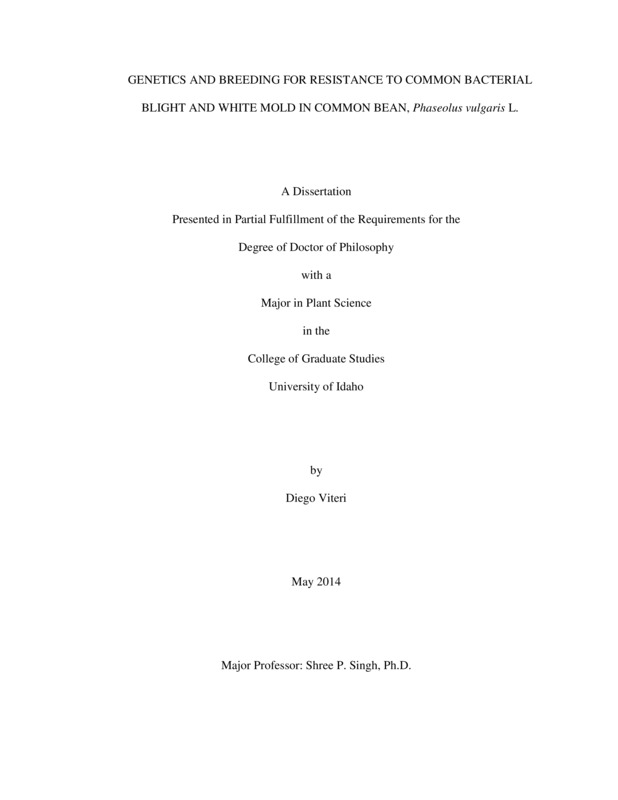GENETICS AND BREEDING FOR RESISTANCE TO COMMON BACTERIAL BLIGHT AND WHITE MOLD IN COMMON BEAN, Phaseolus vulgaris L.
VITERI, DIEGO M.. (2014). GENETICS AND BREEDING FOR RESISTANCE TO COMMON BACTERIAL BLIGHT AND WHITE MOLD IN COMMON BEAN, Phaseolus vulgaris L.. Theses and Dissertations Collection, University of Idaho Library Digital Collections. https://www.lib.uidaho.edu/digital/etd/items/viteri_idaho_0089e_10147.html
- Title:
- GENETICS AND BREEDING FOR RESISTANCE TO COMMON BACTERIAL BLIGHT AND WHITE MOLD IN COMMON BEAN, Phaseolus vulgaris L.
- Author:
- VITERI, DIEGO M.
- Date:
- 2014
- Program:
- Plant, Soil and Entomological Sciences
- Subject Category:
- Genetics; Plant sciences
- Abstract:
-
Common bacterial blight (CBB) and white mold (WM) are important diseases in common bean. Identification of resistant genotypes and new genes/QTL are crucial for their control. The overall goals were to identify resistant genotypes for each disease, determine the genetics of WM resistance in A 195, identify new CBB resistance gene(s)/QTL in VAX 1, and determine the presence or absence of resistance QTL linked sequence characterized amplified region markers for both diseases. The specific objectives are given in each of the four chapters comprising this Doctoral Dissertation. Twenty three genotypes, 61 recombinant inbred lines from `Othello'/VAX 1 and 100 from Othello/VAX 3 were evaluated against two Xanthomonas campestris pv. phaseoli (the cause of CBB) strains in the greenhouse at University of Idaho, Kimberly in 2011 and 2012. Similarly, 31 genotypes were inoculated with ARS12D and ND710 Sclerotinia sclerotiorum (the cause of WM) isolates in the greenhouse in Idaho in 2012, and CO460 and NY133 isolates at Colorado State University, Fort Collins in 2013. Also, the parents and F1, F2, and F3 from Othello/A 195 and A 195/G 122 crosses were evaluated against ARS12D and ND710 isolates in the greenhouse in Idaho in 2011 and 2012. For CBB, the mean trifoliolate leaf score (4.8) was higher than the primary leaf score (2.5). The strain Xcp25 (5.2 trifoliolate) was more aggressive than ARX8AC (4.2 trifoliolate). RCS52-2, RCS53-3, and RCS63-5B with BC420 and SU91QTL, and 08SH840 with SAP6 and SU91 QTL were intermediate (3.5 to 6.2) to both bacterial strains. A novel QTL at Pv11.4 linkage group explained 13 to 23% phenotypic variance for resistance to ARX8AC and 26 to 51% to Xcp25 in leaves. Evaluations of WM at 28 days (Idaho) and 21 days (Colorado) post inoculation were optimum. Breeding line SE152-6 with pyramided resistance and WM2.2, WM7.1, and WM8.3 QTL was resistant (≤4) to all S. sclerotiorum isolates after three inoculations/plant. Two independent complementary dominant genes controlled resistance of WM in Othello/A 195 to each isolate; and a single dominant gene different from the WM2.2, WM7.1, and WM8.3 QTL controlled the resistance in A 195/ G122 to ND710 isolate.
- Description:
- doctoral, Ph.D., Plant, Soil and Entomological Sciences -- University of Idaho - College of Graduate Studies, 2014
- Major Professor:
- Singh, Shree P
- Committee:
- Karasev, Alexander; Miklas, Phillip N; Schwartz, Howard F
- Defense Date:
- 2014
- Identifier:
- VITERI_idaho_0089E_10147
- Type:
- Text
- Format Original:
- Format:
- application/pdf
- Rights:
- In Copyright - Educational Use Permitted. For more information, please contact University of Idaho Library Special Collections and Archives Department at libspec@uidaho.edu.
- Standardized Rights:
- http://rightsstatements.org/vocab/InC-EDU/1.0/

